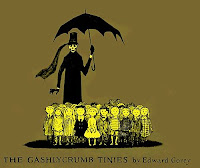 Ranging from gothic to bombastic, Tim Burton’s visual flair is undeniably unique as seen in his films but also in the superb The Melancholy Death of Oyster Boy & Other Stories, a book of tales that he published in 1996. It is filled with tragically funny yarns about children with various defects and accompanied by his own drawings which in their own right are characteristic examples of his infamous macabre style that was also the basis for The Nightmare Before Christmas and Corpse Bride.
Ranging from gothic to bombastic, Tim Burton’s visual flair is undeniably unique as seen in his films but also in the superb The Melancholy Death of Oyster Boy & Other Stories, a book of tales that he published in 1996. It is filled with tragically funny yarns about children with various defects and accompanied by his own drawings which in their own right are characteristic examples of his infamous macabre style that was also the basis for The Nightmare Before Christmas and Corpse Bride.However, he wasn’t the first to start a range stories intertwining death, comedy and the macabre using beautiful yet simple visuals that enhanced the subtleties of the tales. Burton’s biggest influence was none other than the wicked and whimsical Edward Gorey, whose arch nonsense verse and mock-Victorian prose accompany pen and ink drawings of beady-eyed, blank-faced individuals in Edwardian cost
 ume whose dignified demeanour is undercut by silly events leading to their untimely demise.
ume whose dignified demeanour is undercut by silly events leading to their untimely demise. In the 1950s, when the American Gorey was establishing himself as a young artist, the New York school and abstract expressionism dominated the art world and illustration was a tiny art, a mere hobby in fact. In this world, Gorey's closest contemporaries were cartoonists, for example Charles Addams (creator of the legendary Addams Family) who combined the macabre with high-brow ennui. This influenced Gorey to mix simple verse with his dramatic drawings.
Gorey has produced more than 100 small volumes of gothic fables, meticulously hand-lettered and intricately illustrated, most of them in verse. His works are remarkable combinations of the eccentric, the witty, and the macabre and are illustrated lavishly and with superb technique in dark and abundant Edwardian detail. Although picture books, his works emphasize the adult nature  of the content of fairy tales and satirize the conventions of didactic books, especially his many alphabet books. Odd, mysterious, cool, oblique, and very funny, Gorey's works have a completely unique appeal. Gorey's work is reminiscent of a baroque storyboard for a silent film where the juxtaposition of image and text allows us time to consider both, as separate but inseparable p
of the content of fairy tales and satirize the conventions of didactic books, especially his many alphabet books. Odd, mysterious, cool, oblique, and very funny, Gorey's works have a completely unique appeal. Gorey's work is reminiscent of a baroque storyboard for a silent film where the juxtaposition of image and text allows us time to consider both, as separate but inseparable p arts of the same work.
arts of the same work.
Gorey's sinister little tales about haunted, pale-featured characters living in a world filled with bleak, clouded landscapes and gloomy, shadow-filled interiors earned him a reputation as the modern master of American Gothic. While his dark view of the world owed something to the imagination of Edgar Allen Poe, Gorey's work was also evocative of the brooding nightmares of Goya or the decadence of Beardsley. His use of language had the inventiveness of Edward Lear or Lewis Carroll, the extravagance of James Joyce and repetitiousness of Samuel Beckett. What was uniquely his own was the way in which he hinted at, rather than showed, the nastiness that so often lurks beneath the respectable appearance of the tightly buttoned characters who secretly indulge their infidelities and indiscretions as well as their frequently murderous thoughts and deeds.
deeds.
The Loathsome Couple for example is hysterically funny even though it deals with a couple of child murderers. The humor in this story comes from the sheer blandness of it all. The Curious Sofa (where the title of this post is extracted from) on the other hand was sexually explicit and thus self-published. In his work, pornography, like horror, is made all the more shocking by its taking place in the wings or The Gashlycrumb Tinies in which 26 children are alphabetically disposed of one by one. Although these stories frequently and wittily show children or other hapless victims coming to undeserved death, Gorey insisted there was no morbid relish involved. "I see no d isparity between my books and everyday life... I write about everyday life."
isparity between my books and everyday life... I write about everyday life."
He has also illustrated works as diverse as Dracula by Bram Stoker, The War of the Worlds by H. G. Wells, and Old Possum's Book of Practical Cats by T. S. Eliot.
One can also see his influence in the ascendancy of the graphic novel, especially with artists such as Alan Moore and Neil Gaiman.
Gorey's masterful pen and ink illustrations and his ironic, offbeat humor in which grief, despair, loneliness and unexpected (often unnatural) deaths were the common ingredients, have brought him critical acclaim and an avid following throughout the world.



No comments:
Post a Comment